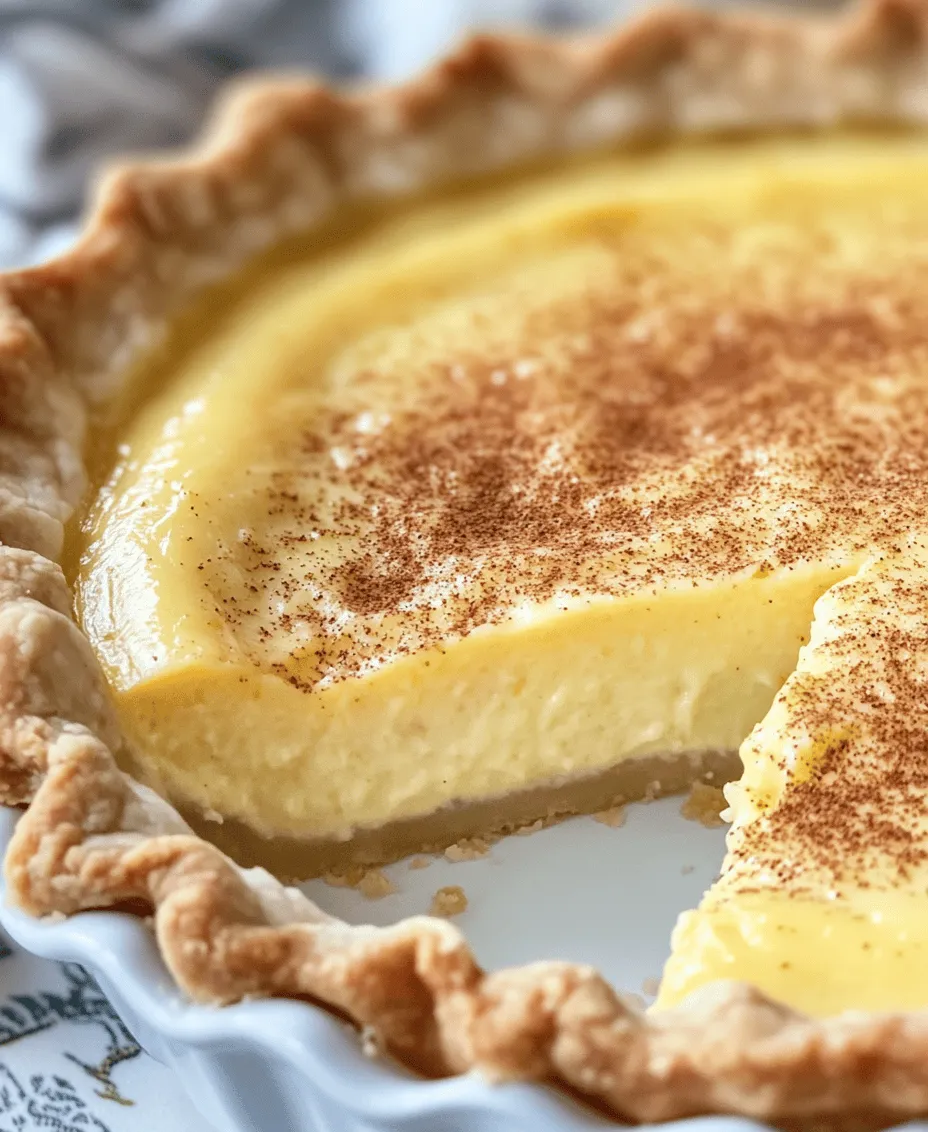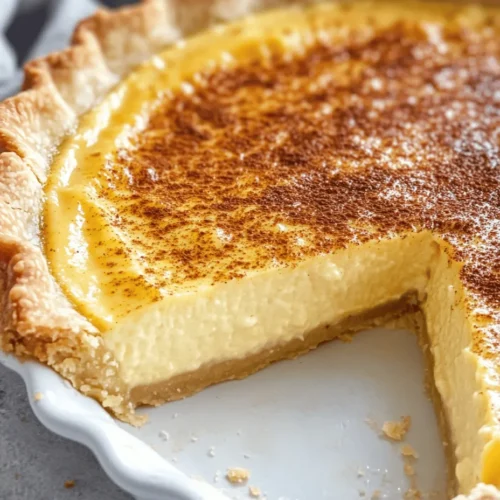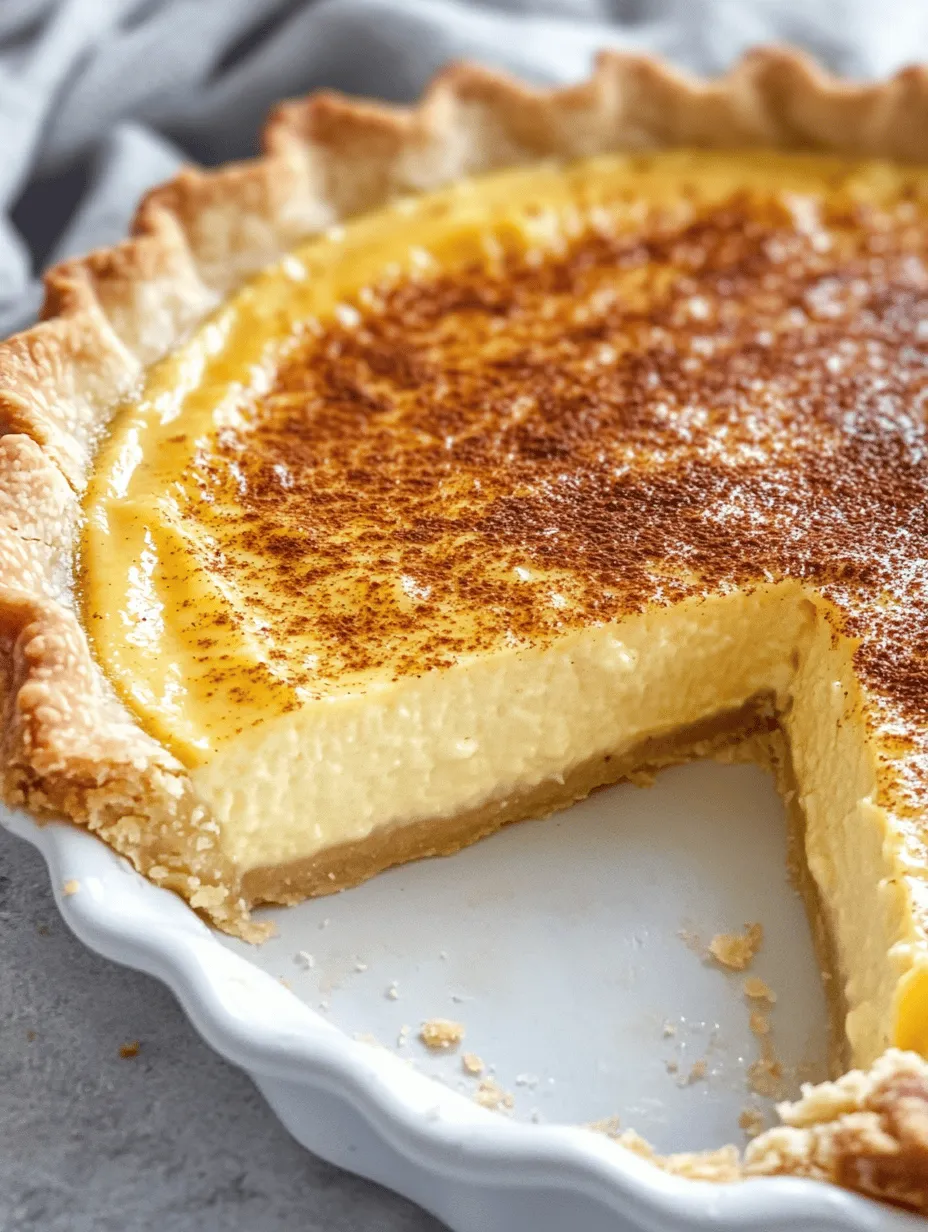The Classic Egg Custard Pie is a dessert that has stood the test of time, capturing the hearts and taste buds of generations. This beloved treat is a perfect embodiment of simplicity and elegance, with its creamy texture and subtly sweet flavor. The allure of this pie lies not only in its delightful taste but also in its nostalgic significance, often associated with family gatherings, holiday celebrations, and cozy evenings spent at home. In this article, we will embark on a journey through the history of custard pies, explore the essential ingredients that make this recipe special, and provide you with detailed preparation steps to help you master the art of baking the perfect egg custard pie.
The History of Custard Pies
Exploring the Origins of Custard Pies
The origins of custard pies can be traced back to medieval Europe, where the concept of custard as a filling began to take shape. Early recipes featured a mixture of eggs, milk, and sugar, encased in a pastry crust. Over time, variations emerged, with different regions adding unique flavors and ingredients. The word “custard” itself is derived from the Old French term “croustade,” which refers to the crust that encases the creamy filling.
As custard pies gained popularity, they were embraced by various cultures and adapted to local tastes. In England, for instance, custard tarts became a common dessert, while in America, the classic egg custard pie emerged as a staple in Southern households. This pie not only provided a delicious way to use leftover eggs and milk but also became a symbol of comfort and home cooking.
Understanding the Cultural Significance of Custard Desserts
Custard desserts, including the classic egg custard pie, hold a special place in culinary traditions worldwide. They are often associated with warmth and hospitality, embodying the spirit of sharing and family gatherings. In American culture, egg custard pie became particularly prevalent during the 19th and 20th centuries, often served at potlucks and family dinners. Its simplicity made it a beloved choice for home bakers, as it required minimal ingredients and could be prepared without any specialized equipment.
Furthermore, custard desserts have been celebrated in literature and art, symbolizing the comforts of home and the joys of indulgence. The smooth, creamy texture of a well-made custard offers a sensory experience that evokes memories of childhood and family traditions. As such, the classic egg custard pie is not merely a dessert; it represents a connection to our past and the comfort of shared experiences.
Classic Egg Custard Pie in American Cuisine
In American cuisine, the classic egg custard pie has become a cherished dessert, particularly in the Southern states. Its roots can be traced back to English settlers who brought their baking traditions to the New World. Over the years, this pie has evolved into various regional interpretations, with some adding spices like cinnamon or nutmeg for an extra layer of flavor.
The classic recipe, however, remains beloved for its straightforward approach. Typically made with a flaky pie crust and a rich custard filling, this dessert showcases the beauty of simple ingredients coming together to create something extraordinary. It is often enjoyed warm or chilled, making it a versatile dessert suitable for any occasion.
Key Ingredients for Classic Egg Custard Pie
A successful egg custard pie hinges on a few essential ingredients that work harmoniously to create its signature flavor and texture. Let’s take a closer look at each component:
Whole Milk: The Foundation of Creaminess
Whole milk is the foundational ingredient in egg custard pie, providing the creaminess that defines this dessert. The fat content in whole milk contributes to a rich and smooth custard, ensuring a luscious mouthfeel. While some variations may use evaporated milk or cream for added richness, whole milk strikes the perfect balance between flavor and texture.
Eggs: The Essential Binding Agent
Eggs are the star ingredient in any custard recipe, serving as the primary binding agent that gives the pie its structure. When whisked and combined with milk, eggs create a smooth and creamy filling that sets beautifully during baking. The proteins in the eggs coagulate as they cook, resulting in that signature custard texture. Fresh eggs are recommended for the best flavor and consistency.
Granulated Sugar: Sweetness and Balance
Granulated sugar adds the necessary sweetness to the egg custard pie, balancing the richness of the milk and eggs. The amount of sugar can be adjusted according to personal preference, but it is essential to use enough to complement the other flavors without overpowering them. The sugar also contributes to the caramelization of the custard as it bakes, enhancing the overall flavor profile.
Vanilla Extract: Enhancing Flavor Profiles
Vanilla extract is a key flavor enhancer in egg custard pie, adding depth and warmth to the custard filling. The aromatic notes of vanilla complement the sweetness of the sugar and the richness of the eggs, creating a well-rounded flavor experience. For an even more pronounced vanilla taste, consider using pure vanilla extract rather than imitation vanilla flavoring.
Salt: A Key Component for Depth
Although it may seem counterintuitive, a pinch of salt is a crucial ingredient in egg custard pie. Salt enhances the overall flavor of the custard, balancing the sweetness and allowing the other flavors to shine. It also plays a vital role in elevating the creamy texture of the filling. Be sure to use a fine sea salt or kosher salt for the best results.
Ground Nutmeg: The Signature Spice
Ground nutmeg is often used as the finishing touch in classic egg custard pie recipes, providing a warm and aromatic spice that elevates the dessert. Nutmeg’s unique flavor pairs beautifully with the creamy custard, adding a hint of complexity. While some recipes may call for cinnamon or other spices, nutmeg remains the traditional choice for a classic egg custard pie.
Preparation Steps for Perfecting Egg Custard Pie
Now that we’ve explored the history and key ingredients of the classic egg custard pie, let’s move on to the preparation steps that will help you create this delightful dessert. Following these steps carefully will ensure a smooth custard filling and a perfectly baked pie.
Preheating the Oven: Setting the Stage for Baking
Before you begin mixing the ingredients, it’s essential to preheat your oven to 350°F (175°C). Preheating ensures that the custard bakes evenly and sets properly. An oven thermometer is a useful tool to have, as it can help you confirm that your oven is at the correct temperature for optimal baking.
Heating the Milk: Achieving the Right Temperature
The first step in making the custard filling involves heating the whole milk. In a saucepan over medium heat, gently warm the milk until it is steaming but not boiling. Heating the milk helps to dissolve the sugar and encourages the custard to set more smoothly. Be sure to stir the milk occasionally to prevent it from scorching on the bottom of the pan.
Once the milk is heated, remove it from the heat and let it cool slightly before proceeding to mix it with the other ingredients. This step is crucial, as incorporating hot milk directly into the egg mixture can lead to scrambling, resulting in a grainy custard. Allow the milk to cool for about five minutes before moving on to the next step.
With a solid understanding of the history, key ingredients, and initial preparation steps for classic egg custard pie, you are now well on your way to creating this timeless dessert. Stay tuned for the next part, where we will delve into the remaining steps and tips that will guide you in perfecting your egg custard pie.

Mixing the Eggs and Sugar: Creating a Smooth Base
To begin crafting your classic egg custard pie, the first step is mixing the eggs and sugar. Start by cracking four large eggs into a mixing bowl. Using a whisk or an electric mixer, beat the eggs gently until they are just combined. This initial mixing is crucial as it helps incorporate air into the eggs, which will contribute to the custard’s light texture.
Next, gradually add in three-quarters of a cup of granulated sugar. It’s important to add the sugar slowly to ensure it dissolves completely, preventing any graininess in your final custard. Continue to whisk until the mixture is smooth and the sugar is fully integrated. This should take about 2-3 minutes of gentle whisking. The result should be a light yellow base that is creamy and slightly frothy.
Combining Ingredients: The Art of Whisking
Once the eggs and sugar are blended, it’s time to enrich the custard with milk and flavorings. Measure out two cups of whole milk, ensuring it is at room temperature for better emulsification. Slowly pour the milk into the egg-sugar mixture while whisking continuously. This technique helps to temper the eggs, preventing them from scrambling when they encounter the heat of the milk.
After incorporating the milk, add in one teaspoon of vanilla extract for depth of flavor. For a subtle twist, consider adding a pinch of nutmeg or cinnamon—these spices can elevate the flavor profile of your pie. Whisk the mixture until it is completely blended and smooth. This step is essential as it ensures that the custard base is homogenous and free of lumps.
Straining the Mixture: Ensuring a Silky Custard
To achieve the perfect silky texture, straining the custard mixture through a fine-mesh sieve is recommended. Place the sieve over a clean bowl or the prepared pie crust. Carefully pour the custard mixture into the sieve, allowing it to filter through while catching any undissolved egg or clumps of sugar. This step may seem tedious, but it is critical for a luxurious, smooth custard that melts in your mouth.
As the custard passes through the sieve, use a spatula or the back of a spoon to gently push it through, ensuring you extract as much liquid as possible. Discard any solids left in the sieve. The strained custard should have a beautiful, velvety consistency ready to be poured into the pie crust.
Pouring into the Pie Crust: Techniques for a Clean Fill
With your pie crust prepared—whether homemade or store-bought—it’s time to fill it with the custard. Pre-bake your pie crust at 375°F (190°C) for about 10 minutes until it’s lightly golden. This pre-baking step helps prevent a soggy bottom.
When pouring the custard into the crust, do so slowly and steadily to avoid splashing. Start at the edge of the crust and allow the custard to flow gently toward the center. If you notice any bubbles on the surface, gently tap the pie dish on the counter to release them. This technique helps achieve an even and aesthetically pleasing custard layer.
Baking: Understanding the Right Timing and Temperature
Baking the pie is where the magic happens; it transforms the liquid custard into a creamy, set filling. Preheat your oven to 350°F (175°C) for the best results. Once preheated, place the pie on the middle rack. Bake for approximately 40-45 minutes or until the edges are set, and the center has a slight jiggle.
To check for doneness, insert a knife or toothpick into the center of the pie. The knife should come out clean, indicating that the custard is properly cooked. If the edges begin to brown too much while the center is still jiggly, cover the edges with aluminum foil to prevent over-browning.
Cooling and Serving: The Importance of Patience
Once your egg custard pie is beautifully baked, it’s essential to allow it to cool gradually. Remove it from the oven and let it sit at room temperature for about 30 minutes. This cooling period helps the custard set further, enhancing its texture. After it cools, transfer the pie to the refrigerator for at least 2 hours, or ideally overnight. Chilling allows the flavors to meld and deepens the custard’s richness.
When ready to serve, slice the pie into wedges. For added presentation, consider dusting the top with a light sprinkle of nutmeg or cinnamon. Serve the pie chilled or at room temperature, and pair it with whipped cream or a scoop of vanilla ice cream for an indulgent treat.
Tips for a Successful Egg Custard Pie
Choosing the Right Pie Crust: Store-Bought vs. Homemade
The choice of pie crust can significantly affect the overall taste and texture of your egg custard pie. A store-bought crust offers convenience, while a homemade crust allows for customization in flavor and texture. If you opt for a homemade crust, consider using a buttery, flaky pastry recipe to complement the creamy custard. For a gluten-free option, almond flour or oat flour crusts can be delightful choices.
Adjusting Flavor Profiles: Experimenting with Spices
While the classic egg custard pie typically features vanilla, feel free to experiment with flavors. A touch of lemon zest or almond extract can provide a refreshing twist. Additionally, spices like ginger, cardamom, or even a hint of lavender can bring a unique twist to the traditional recipe. Adjusting these flavors can personalize the pie and make it a signature dessert.
Achieving the Perfect Bake: Indicators of Doneness
Watch for visual cues to determine doneness. The edges should appear set, while the center may still have a slight jiggle—this is normal as it will continue to firm up during cooling. If you are unsure, a quick thermometer check can help; the internal temperature should reach around 170°F (77°C) when properly baked.
Presentation Ideas: Serving Suggestions for Any Occasion
Presentation can elevate the experience of your egg custard pie. Consider garnishing with fresh berries or a drizzle of caramel sauce for a stunning visual appeal. For a rustic look, serve slices with a dollop of whipped cream on top, perhaps with a sprinkle of grated chocolate or toasted nuts. These finishing touches can turn a simple pie into a dessert that impresses at any gathering.
Nutritional Information of Egg Custard Pie
Caloric Content and Portion Size
Understanding the nutritional value of your egg custard pie can enhance your enjoyment of this classic dessert. The caloric content of a slice of traditional egg custard pie typically ranges from 200 to 300 calories, depending on the size of the slice and the specific ingredients used. For a standard 9-inch pie, it’s often divided into 8 slices, making portion control easier.
Understanding Nutritional Values of Key Ingredients
Key ingredients like eggs, milk, and sugar play significant roles in the nutritional profile of the pie. Eggs provide high-quality protein and essential vitamins, while whole milk adds calcium and healthy fats. The sugar content contributes sweetness but should be consumed in moderation as part of a balanced diet.
Balancing Indulgence with Nutrition
While egg custard pie is undeniably a treat, it can be enjoyed as part of a balanced approach to eating. If you’re looking to lighten the recipe, consider using a reduced-fat milk or substituting some of the sugar with natural sweeteners like honey or maple syrup. Additionally, serving the pie alongside fresh fruit can enhance its nutritional benefits while adding a refreshing contrast to the rich custard.
Conclusion: The Enduring Appeal of Classic Egg Custard Pie
Classic Egg Custard Pie is more than just a dessert; it is a reflection of tradition, comfort, and creativity in the kitchen. Its straightforward ingredients and simple preparation make it accessible to bakers of all levels, while its rich flavor and creamy texture ensure it remains a cherished favorite. As you embark on creating this classic dish, may it inspire joy and nostalgia, reminding us of the sweet moments shared around the table.
Embrace the process of making egg custard pie, and don’t hesitate to add your own personal touch to the recipe. Whether serving it at a holiday gathering, a family dinner, or simply enjoying it with a cup of tea, this pie is sure to evoke smiles and fond memories for years to come. Happy baking!



